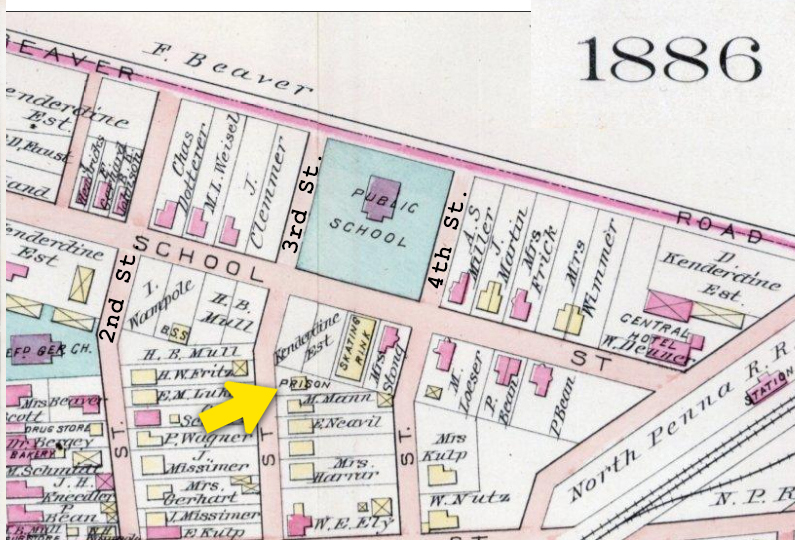We continue with the Town Council meeting of January 20, 1870:
“The council then resolved itself into a committee of the whole and the following propositions submitted: E. K. Freed proposed that a stone building sixteen feet square ten feet high with flat roof covered with tin be erected. Joseph K. Anders coincided with Mr. Freed. Percival Slough proposed to have three apartments, one for prisoners, one for male and the other for female lodgers.
“After considerable discussion, in which all members of the council participated, the following was unanimously adopted as the specifications of the building; the building or lock-up house to be stone fourteen by eighteen feet, one story high, nine feet in the clear from floor to ceiling, wall to be eighteen inches thick laid up with good lime and sand mortar, the sleepers to be of white oak six inches thick and laid thirty inches apart, hemlock floor to be laid not less than thirty inches above the level of the surrounding ground, the joist for the ceiling to be three by six inches, to have four windows with two lights (by lights they meant window panes) in each, 10 by 12 glass with one iron bar lengthwise in each, well secured and to be one inch in thickness, to have a brick partition wall nine inches thick, two 2 inch batten doors well nailed with wrought iron nails, hung with strap hinges and have good mortise lock, flat tin roof to project eight inches over the wall with plain cornice around the same, the ceiling to be plastered with two coats and the walls inside with one coat of good mortar, the outside to be roughcast, and the outside woodwork to be well painted with two coats of white lead, and have suitable privy arrangements in each apartment for the accommodation of lodgers. The same to be completed by the 15th day of April A. D. 1870.

“All the material and workmanship in the same shall be such as shall be approved by the Town Council, under a penalty or forfeiture of one hundred dollars, after the adoption of which the clerk was in-structed to make out specifications and invite proposals for the building of the same.”
“Bids for the construction of the lock-up were received at the meeting of February 2, 1870, when the following propositions were received and read: one from Frederick Wolf for three hundred and thirty-five dollars. One from Aaron Kriebel for three hundred and sixty dollars, which were considered, and on motion it was resolved that the proposal for Mr. Wolf be accepted upon condition that he give security for the faithful performance of the contract agreeably to the specifications, under a forfeiture of one hundred dollars.
“The committee appointed at the special session of council on the 20th of January, 1870, for the purpose of purchasing a suitable lot of ground on which to build the lock-up, reported that they had made arrangements with David Moyer for the purchase of a lot on Third street for the sum of fifty dollars, subject to a dower of about four dollars, which report was accepted. This plot of ground was at Third and School streets, and the lock-up, when erected, stood about where the buildings now [1959] stand that are now owned by the Atlas Asbestos Company.
The next mention of the lock-up is made in the borough minutes of April 6, 1870, and reads as follows: “Messrs. Moyer and Slough, the committee appointed to superintend the building of the lock-up, or station house, report that the same is completed agreeably to contract, which was on motion accepted.”
Frederick Wolf, the contractor, was present and claimed ten dollars extra pay for changing the location of the building from the foundation first dug to where it was finally located. Upon Mr. Wolf persisting in his claim, it was on motion of E. K. Freed allowed and an order granted in his favor for $345.00. At this same meeting the building committee was instructed to place an iron bar across the outer door of the lock-up.
The lock-up having been erected, the next matter of importance to be brought to the attention of council was the question of street lights. On October 5, 1870, there appears in the minutes the following entry: “Application by petition of citizens of the borough having been made to the Town Council for the erection of street lamps at certain points in the limits of the borough of North Wales, in pursuance of which application, it was on motion of Mr. Freed unanimously resolved that the question of lamps to light the streets of the borough be submitted to the qualified electors therein at the general and borough elections to be held at the public house of Abel Lukens on the 11th day, being the second Tuesday of October A. D. 1870.”
We will report the result of this election in our next article.
This post is sourced from a column entitled Early North Wales: Its History and Its People penned by long-time North Wales resident historian Leon T. Lewis. The article appeared in its original form in the August 25, 1959 issue of the North Penn Reporter.
